Some days feel like you’re riding a rollercoaster with no seatbelt. One moment you’re on top of the world, the next you’re stuck in a gloomy loop.
Mood tracker apps can act like little sidekicks, helping you map your emotional ups and downs. They show patterns, reveal triggers, and even help you celebrate the small wins when your mood improves. Think of them as your personal weather app, but for your feelings.
Taking care of your mental health is more important than ever. The World Health Organization (WHO) estimates that around one in eight people worldwide is living with a mental disorder. Using a mood tracker can be a simple way to spot patterns, manage stress, and take little steps to feel better each day.
Keeping track of your mood doesn’t have to be complicated or stressful. A quick daily check-in can reveal surprising patterns, like how certain routines lift your spirits or which habits might be draining you. Over time, you start understanding your emotions better and spotting trends before they spiral.
Grab a cup of coffee, and let’s go through the top 7 mood tracker apps for 2026, see what makes each one unique, and figure out which one could work best for you.
1. Calm
Calm wraps around you like a cozy blanket after a hectic day, bringing comfort, relaxation, and a sense of peace. Beyond meditation and sleep stories, Calm also lets you track your mood and notice patterns in your emotional well-being, making it one of the top mental health apps in 2026.
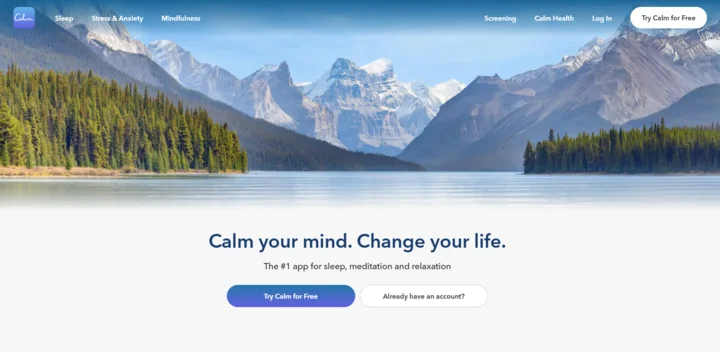
Key Features
When it comes to what Calm actually offers, there’s a lot packed in to help you feel centered and relaxed every day.
Here are some of the key ways it supports your mental well-being:
Table of Contents
- Guided meditation sessions to reduce stress and improve focus.
- Breathing exercises that calm your mind in just a few minutes.
- Sleep stories and music to help you fall asleep easily.
- Daily mood tracking to notice emotional patterns over time.
- Relaxation programs are designed for anxiety and mindfulness.
User Experience (UX)
The app feels gentle and inviting. Soft visuals, smooth navigation, and calming animations make it easy to open Calm, even when your brain feels like it’s running a million miles per hour.
Mental Health Insights
Using Calm regularly helps you spot patterns in stress and anxiety, giving you a better understanding of your emotions. Meditation, breathing exercises, and sleep tools support overall emotional well-being, making it easier to manage mood swings and stay balanced.
2. Headspace
Headspace works like a friendly coach in your pocket, gently guiding you to pause, breathe, and check in with yourself. Beyond the famous guided meditations, you can track your daily mood and notice patterns, helping you stay on top of your emotional well-being.
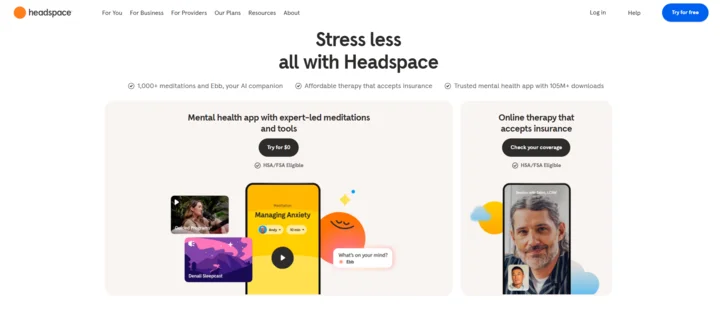
Key Features
If you’re curious about how Headspace can actually help you day-to-day, here are the key ways it supports your mental health and keeps you feeling balanced:
- Guided meditation sessions for stress relief and mental clarity.
- Breathing exercises to calm your mind in just a few minutes.
- Daily mood tracking to monitor emotional patterns.
- Sleep exercises and soundscapes to improve rest and relaxation.
- Mindfulness exercises are designed to manage anxiety and boost emotional well-being.
User Experience (UX)
Headspace feels playful yet calming. Bright, friendly illustrations and smooth navigation make it easy to check in daily. Reminders are gentle, so tracking your mood or doing a short meditation never feels like a chore.
Mental Health Insights
Using Headspace consistently can help you spot patterns in stress, anxiety, and mood swings. Regular check-ins encourage mindfulness and improve emotional well-being, helping you better manage your reactions to daily stress.
3. Daylio
Daylio turns mood tracking into a playful, pocket-sized journal where emojis and quick notes reveal patterns over time. Instead of writing long entries, you just pick an emoji that matches your mood and jot a few notes. Over time, patterns start to reveal themselves, sometimes in surprising ways.
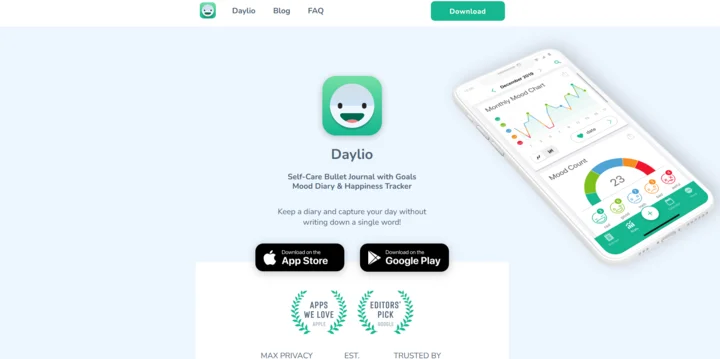
Key Features
Daylio makes tracking your moods simple and insightful with features like:
- Quick micro-journaling to capture your daily mood.
- Habit tracking to see what lifts or drains your spirits.
- Colorful charts showing trends over weeks or months.
- Mood logging with customizable icons and notes.
- Reminders to encourage consistent check-ins.
User Experience (UX)
Daylio’s interface is bright, playful, and intuitive. Logging your mood takes seconds, and charts make it easy to see patterns at a glance.
Mental Health Insights
Daylio highlights triggers and trends in your mood. Noticing which habits or routines affect your emotions allows you to make small adjustments that improve overall well-being.
Struggling to make your mood tracking app simple and enjoyable? The right UX design experts can turn every tap and swipe into an engaging experience.
4. Moodfit
Moodfit acts as a mental fitness trainer, offering exercises and tools to strengthen emotional resilience.
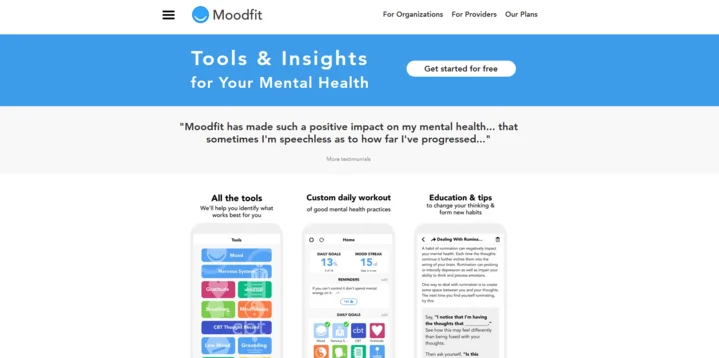
Key Features
Looking for a structured way to improve your mental well-being? Moodfit brings everything together in one place:
- Mood tracking to monitor emotional patterns.
- Therapy-inspired exercises to manage stress and anxiety.
- Sleep and activity tracking for a holistic approach.
- Goal setting to encourage healthy habits.
- Progress charts to visualize emotional growth.
User Experience (UX)
The app is clean, structured, and easy to navigate. Visual progress trackers make emotional “workouts” feel motivating and rewarding.
Mental Health Insights
Moodfit helps identify triggers and patterns in stress, anxiety, and mood swings. Regular tracking builds coping strategies and provides clarity about emotional health.
5. Moodnotes
Moodnotes is like having a friendly psychologist in your pocket. It encourages reflection without feeling intimidating, helping you develop healthier thought patterns over time.
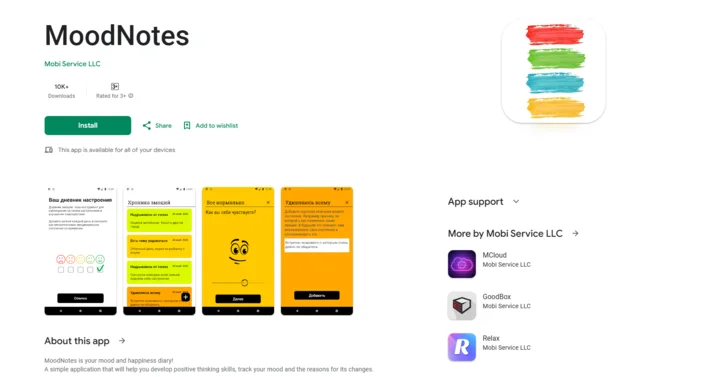
Key Features
Curious about what makes Moodnotes worth opening every day? Here’s a peek at its main tools:
- Thought journaling to capture reflections.
- Mood tracking to notice patterns over time.
- Prompts to challenge negative thinking.
- Insights to improve emotional awareness.
- Visual charts that show trends in mood.
User Experience (UX)
The app is minimalistic, smooth, and welcoming. Journaling is simple, and visuals make reflection approachable rather than like a chore.
Mental Health Insights
Moodnotes promotes self-awareness and helps spot recurring patterns in thoughts and moods. Regular reflection reduces stress and improves emotional clarity.
6. eMoods
eMoods provides a structured diary for mental health, making it easier to track moods, symptoms, sleep, and progress.
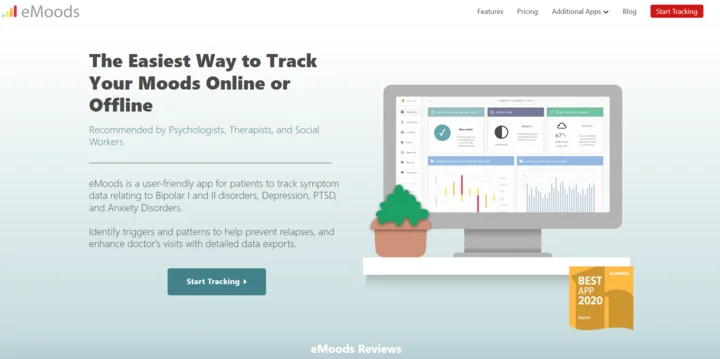
Key Features
If you want a serious, organized way to keep tabs on your moods, eMoods has you covered:
- Detailed mood logging for clarity.
- Symptom tracking for conditions like anxiety or bipolar disorder.
- Sleep and medication tracking for holistic insights.
- Secure privacy settings for peace of mind.
- Charts and reports to visualize trends.
User Experience (UX)
eMoods is practical yet user-friendly. The structured layout makes logging moods simple, and charts provide a clear visual representation of trends.
Mental Health Insights
eMoods helps notice patterns in moods and symptoms, making it easier to manage anxiety, depression, or other emotional challenges. It also provides data you can share with healthcare providers if needed.
7. Reflectly
Reflectly feels like a chatty journal that actually listens. Prompts encourage reflection and mindfulness, turning mood tracking into a fun daily habit.
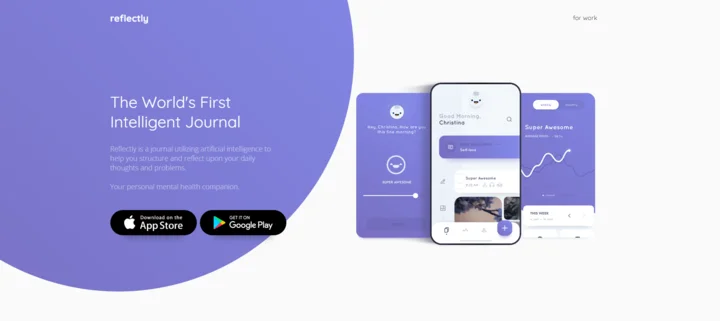
Key Features
Want to know why Reflectly feels so engaging? Check out the features that make it fun:
- AI-guided journaling with daily prompts.
- Mood tracking to notice patterns.
- Motivational insights to encourage reflection.
- Visual charts to track trends over time.
- Friendly reminders to keep journaling consistent.
User Experience (UX)
Reflectly feels playful, smooth, and engaging. Entering your mood takes just a few taps, and the colorful design makes daily reflection something to look forward to.
Mental Health Insights
Reflectly helps spot patterns in thoughts and feelings. Regular reflection encourages mindfulness and strengthens emotional awareness over time.
Which Mood Tracker App Is Right for You?
It’s easy to feel a bit lost when scrolling through the app store. Everything promises better sleep, less stress, or more balance, but not every app will actually fit into your life. Think of it like trying out a new routine: some stick, some don’t.
The important thing is finding an app that feels effortless and doesn’t add extra pressure to your day. With the right approach and guidance from expert mobile app developers, a mood tracker app can be intuitive, enjoyable, and truly helpful, making daily check-ins feel natural rather than like a chore.
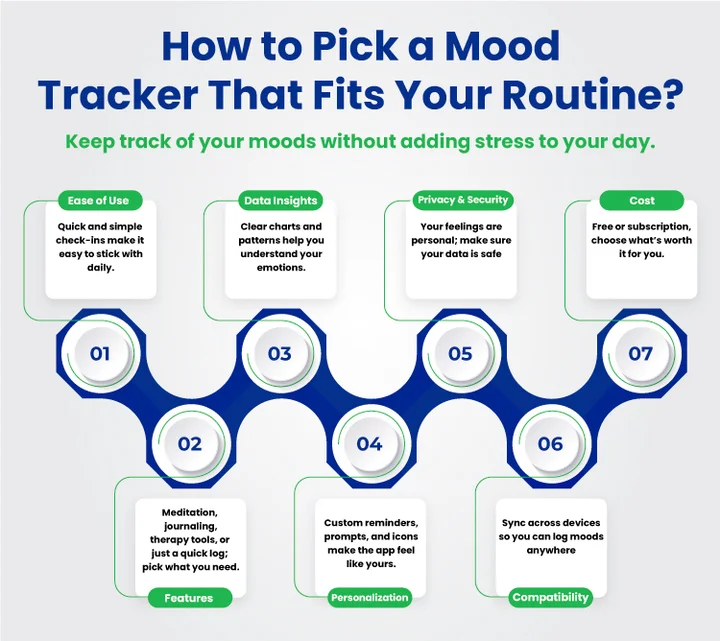
Here are a few things to keep in mind while figuring out which app could be your best match:
- Ease of use: If it takes more than a minute to log your mood, you probably won’t keep up with it.
- Features: Decide if you want meditation, journaling, therapy tools, or just quick check-ins.
- Data insights: Look for charts and patterns that actually help you understand your emotions.
- Personalization: Custom reminders, prompts, or icons can make the app feel more “yours.”
- Privacy & security: Your feelings are personal, so it’s worth checking how the app protects your data.
- Compatibility: Apps that sync across devices make it easier to keep track anywhere.
- Cost: Some are free; others require subscriptions for premium tools. It’s about what feels worth it to you.
Keep these points in mind, and you’ll be much closer to finding an app that actually fits your routine and makes checking in with your mood feel easy, not like a chore.
Final Thoughts
Moods can feel unpredictable, like plot twists in your favorite show. These apps help notice, reflect, and respond, giving more control over emotional ups and downs.
From Calm’s cozy meditations to Daylio’s playful journals, Moodfit’s mental fitness approach, and eMoods’ detailed tracking, there’s an app for every style.
Pick one, stick with it for a few weeks, and watch how small check-ins can make a real difference. Your mind and your coffee breaks might feel a little calmer for it.
If you’re planning to develop a mood tracking app, picking the right UX design solutions can make a big difference in keeping users engaged and happy with the app.
Take a moment for yourself; it matters more than you think!
Frequently Asked Questions (FAQs)
2. Are Wellness Apps Accurate For Clinical Use?
Most digital health apps and mHealth apps are not medical devices, but they are useful for spotting lifestyle trends. They give a clearer view of patient behavior and progress, supporting data-driven healthcare and better patient communication.
3. Can Wellness Apps Connect With Hospital Or Clinic Systems?
Yes. Many patient health apps now offer healthcare app integration, allowing their data to sync with electronic health records (EHRs). This creates a unified view that combines clinical data with lifestyle and wellness information for improved decision-making.
4. Is Patient Data Safe When Using Wellness Apps?
Privacy is a top priority. Trusted mobile health apps follow strict regulations such as HIPAA or GDPR. Patients should always review app permissions and understand how their data is used to ensure safe and transparent digital patient engagement.
5. What Are Some Of The Best Apps For Patient Health Insights?
It depends on the goal. For activity tracking, apps like Fitbit or Garmin are popular. For mental wellness, Calm or Headspace works well. For chronic care, tools like MySugr or Omron are effective. The best health tracking apps are those that patients can use consistently to support better clinical outcomes data.
Worried your app might lose users before they even start? Effective UI/UX design solutions can make navigation effortless and keep users coming back.




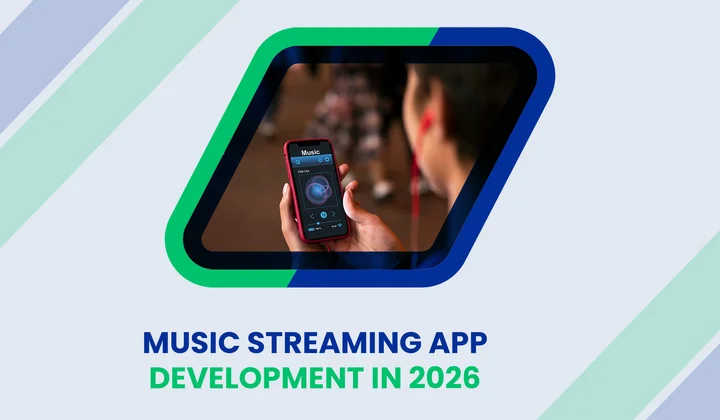


Share your thoughts about this blog!